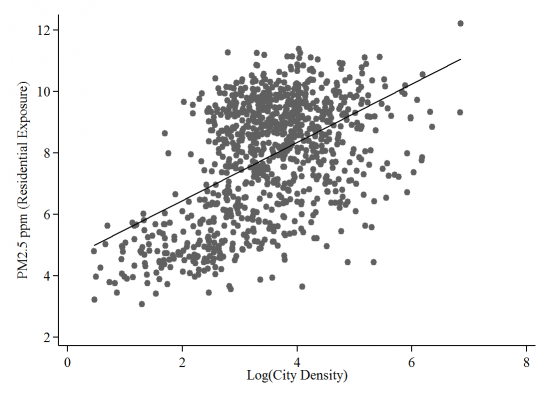
 Where urban planning is concerned, the conventional wisdom is that more compact cities are greener. While this may be the case for greenhouse gas emissions, new research on US cities from Sefi Roth and Felipe Carozzi find that denser cities are also more likely to have greater concentrations of harmful air pollution which can be detrimental to human health and well-being.
Where urban planning is concerned, the conventional wisdom is that more compact cities are greener. While this may be the case for greenhouse gas emissions, new research on US cities from Sefi Roth and Felipe Carozzi find that denser cities are also more likely to have greater concentrations of harmful air pollution which can be detrimental to human health and well-being.
Air pollution is bad for us. We all know that polluted air is detrimental to our health and recent research shows that it can also affect our performance in education, productivity at work and even our safety. This has important implications for our cities. Why? Because air pollution is primarily an urban problem. It is in large cities and their urban cores where we typically experience the worst air quality. As a result, the economist’s textbook description of urbanization lists air pollution as one of the forces that prevents cities from growing, with bigger cities associated with higher levels of air pollution. Since it is an urban problem, air pollution exposure can be shaped by urban planning and policy. In particular, it can be affected by population density, the defining feature of urbanization that distinguishes cities from smaller towns and villages.
In new research we study how air pollution – as measured by the concentration of fine particulate matter like dust and soot (PM2.5) – is shaped by cities’ population density in the United States. For this purpose we use new data on satellite-derived measures of PM2.5 concentration at a fine spatial scale and demographic information from the US census. Using different statistical techniques to deal with potential confounders, we estimate the effect of population density on urban air pollution both between and within cities. Our estimates point to a definitive conclusion: denser locations are associated with higher concentrations of PM2.5. How much higher? Quite a bit.
According to our estimates, doubling density – say, increasing the density in Houston to match that of Chicago – increases PM2.5 concentrations by 0.73 μg/m3, which is roughly 10 percent of the average pollution across cities. Using well established functions that map pollution concentration to mortality rates, in conjunction with official mortality costs estimates from the US Environmental Protection Agency, we find that doubling densities would lead to annual mortality costs (the lost income which could be attributed to disease or a shortened lifespan) of as much as $630 per person. Figure 1 shows the relationship between population density and pollution:
Figure 1 – PM2.5 Concentration and Population Density

Note: Vertical axis represents PM2.5 average residential exposure (in μg /m3), as obtained from the satellite-derived measures. Horizontal axis represents the natural logarithm of population density. The points represent 933 CBSAs (metro and micropolitan areas). The black line is estimated by OLS using the underlying data.
So denser cities lead to higher pollutant concentration. Is this really that surprising? Well, if one reads the recent literature on green cities, it definitely is. A prolific strand of research has emphasized the environmental advantages of denser cities. In dense cities, households enjoy shorter commutes when driving to work, and may even switch to other transport modes when these are available. In a world in which a significant amount of emissions are generated by transport – especially driving – this observation has led to the conclusion that denser cities are also greener. But our results indicate that this picture is not as straight forward as it might seem. Yes, denser cities may be associated with lower emissions which is important for reducing global greenhouse gas concentrations.
However, if we are concerned about air quality within our cities, having lower emissions does not suffice. What hurts our lungs, our hearts – and almost every organ in our bodies – is not total emissions per se, but the concentration of pollutants in the air that we actually breathe. Our research shows that pollution exposure is higher in denser cities, making the environmental quality in these cities lower than in other locations.

Photo by Zhu Liang on Unsplash
What should be done?
For decades now, the compact city approach to urban planning has promoted urban densification as a way to contain sprawl, reduce car use and promote some of the beneficial agglomeration forces normally associated with density. There are many things to enjoy about compact cities, including shorter commutes and better access to commercial and recreational activities. Yet our results indicate that the purported environmental advantages of compactness may be limited to reductions in pollutants which contribute to the global climate emergency. When it comes to our lungs and hearts, denser cities create a more polluted, harmful environment. Urban planners should take note of these trade-offs when designing the cities of the future.
- This article is based on CEP Discussion Paper No 1635 ‘Dirty Density: Air Quality and the Density of American Cities’
Please read our comments policy before commenting.
Note: This article gives the views of the author, and not the position of USAPP – American Politics and Policy, nor the London School of Economics.
Shortened URL for this post: http://bit.ly/2N4aQ8l
About the authors
 Sefi Roth – LSE Geography and Environment
Sefi Roth – LSE Geography and Environment
Sefi Roth is an Assistant Professor of Environmental Economics in the Department of Geography and Environment at the LSE. He is also an Associate of the Grantham Research Institute on Climate Change and the Environment. His research concentrates on environmental economics, economics of education, labour economics and health economics.
 Felipe Carozzi – LSE Geography and Environment
Felipe Carozzi – LSE Geography and Environment
Felipe Carozzi is an Assistant Professor of Urban Economics & Economic Geography in the Department of Geography and Environment at the LSE.







I find this quite an extraordinary assertion and deeply misleading. You are keeping the pollution level constant and assuming a doubling of density even though we know that denser cities promote lower emissions and hold the potential for a significant reduction in all kinds of pollutants.
Of course, if you magically double Houston’s density tomorrow, but keep vehicle use the same you are going to have a serious issue with PM exposure. But that is absolutely NOT what advocates of compact cities advocate and also not how urban densification works. The reason Houston has high PM 2.5 levels in the first place is because everybody drives gas guzzling cars to travel across the sprawling city. Compact cities are not just about density – they are also about connectivity and ensuring that there is a well developed public transport network and facilities for walking and cycling that will drastically cut vehicle emissions.
This is not to say that air pollution isn’t a serious issue urban planners should be concerned about (urban greening in dense cities is essential), but suggesting that compact cities are promoting PM 2.5 exposure when it is in fact urban sprawl and car oriented development that lead to high air pollution is an extremely dangerous narrative. This is the argument put forward by people opposing the cycle lanes along the Embankment because reducing road width = greater congestion = greater localised air pollution impacts. An insane logic that means we remain forever stuck in our current broken cities. Who do you think will benefit from your research and this type of simplistic messaging? The very industries and businesses that benefit from a continuation of the status quo of sprawling, low density, car centric and fossil fuel dependent urban development that have ruined American cities and are now ruining the world.
@Catarina Heeckt: Putting polluters together increases pollutant concentration. That is the basic message. Now, you and others argue – correctly, I believe – that bringing polluters together also reduces emissions by individual polluters. That variation is also in our data. But our results indicate that this is simply not enough to compensate for the effect of getting people closer to each other. To be honest, we do not even think this is that surprising.
Given that CO2 is a global pollutant there is still an argument for densification on environmental grounds, but not on the basis of improved local air quality.
I know the compact city agenda is more sophisticated than simply increasing density, but these first-order effects are important and should not be dismissed on the grounds that they are inconvenient for that agenda.
Really interesting read! It makes sense for densely populated cities to be more polluted. In urban areas, people are constantly exposed to particulate matter, NO, NO2, carbon di-oxide, black carbon, and SO2. This takes a massive toll on health! And the impact is even being seen during the pandemic. More people in urban areas are being impacted.